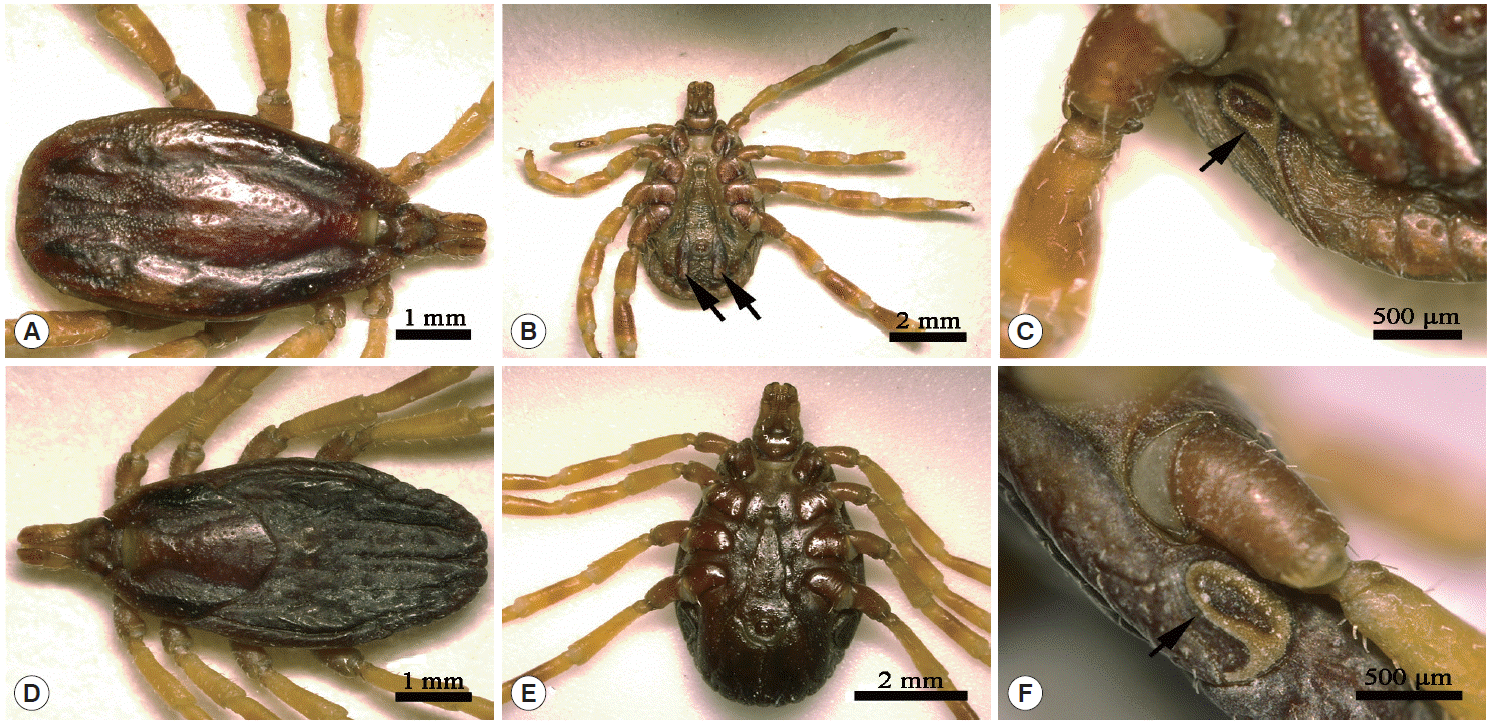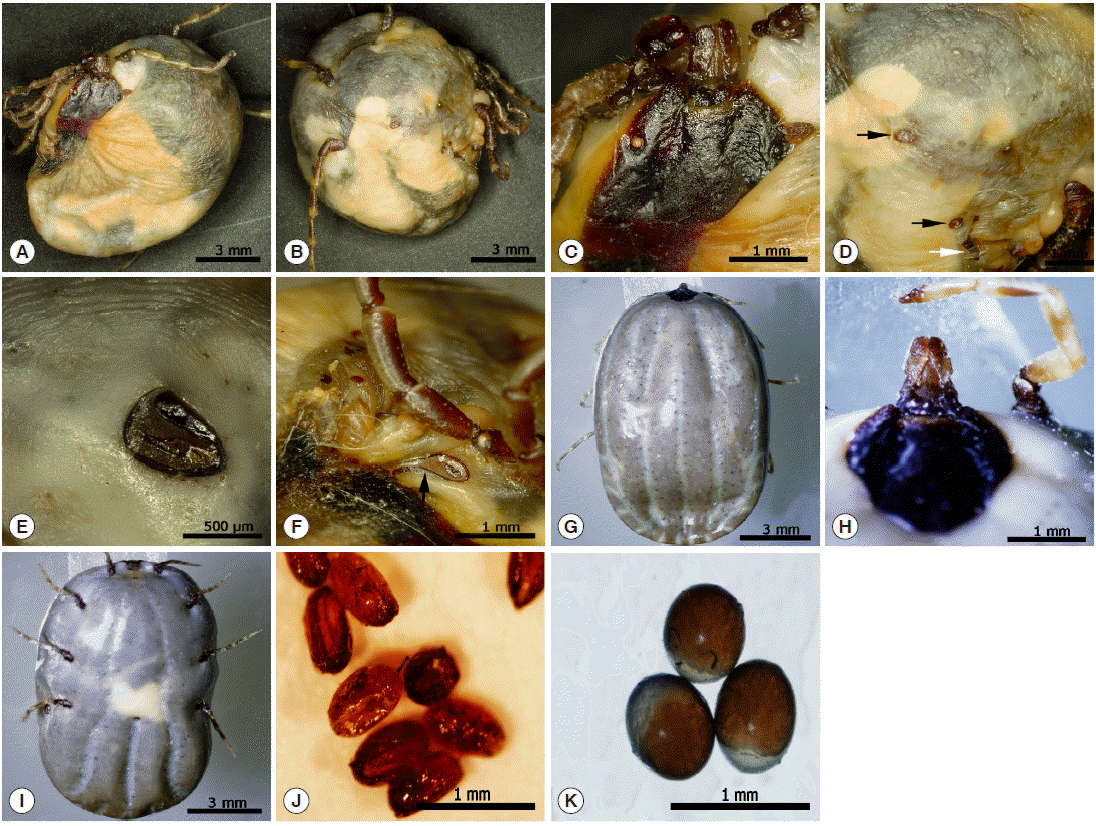Abstract
Gynandromorphic ticks are extremely rare, and often attract parasitologists’ attention. During our examination of tick specimens, an engorged gynandromorph of Hyalomma asiaticum was noticed. This is the first record of gynandromorphic ticks from China. In this study, several important morphological structures of normal and gynandromorphic H. asiaticum were analyzed. Comparing to the normal H. asiaticum, the gynandromorphic specimen was a typical bipartite protogynander. Its right side showed normal female characteristics, whereas the left side had normal male traits. Different from other gynandromorphic ticks containing 1 anus, this tick reported here had 2 complete anuses, and the anus of the male part had a single adanal plate.
-
Key words: Hyalomma asiaticum, gynandromorphism, normal population
Gynandromorphs are chimeric individuals simultaneously possessing male and female characteristics. Unlike plants and some groups of animals, ticks are sexually dimorphic, and gynandromorphs are extremely rare (about 1/14,000 in adult ticks) [
1,
2]. More than 60 cases of gynandromorphism have been documented in the family Ixodidae, and 22 cases were in the genus
Hyalomma [
3-
12]. Feldman-Muhsam [
10] described 8 abnormalities in
Hyalomma savignyi, 3 of which were somewhat gynandromorphs. One case was a laboratory-bred male showing a female spiracular plate on 1 side of the body, with the great reduction of anal and adanal shields, and the wanting of subanal shield. The second case was a pseudogynandromorph that the specimen was considered to a male tick, but the anterior part of its scutum exhibited female characteristics. The third is a female displayed both of the male and female features on 1 stigma. Clarke and Rechav [
9] reported 3 cases of gynandromorphism in
Hyalomma truncatum, all of which predominantly displayed female characteristics. Recently, a case of gynandromorphism in
Hyalomma marginatum was reported by Keskin et al. [
3]. The specimen displayed female features with some pieces of male conscutum in dorsal view, and displayed disorderly female and male features in ventral view. However, up to now, no gynandromorphic ticks have been reported in China.
Hyalomma asiaticum Schulze and Schlottke, 1930 is a common species in Asia, from Syria in the West to eastern China in the East [
13]. Many adult ticks have been identified by many acarologists to date, but there have been few reports of gynandromorphism in the tick species of
H. asiaticum. Only Campana-Rouget [
14] reported gynandromorphic
H. asiaticum briefly, but in the language of Russian. Additionally, the gynandromorphic specimen of
H. asiaticum in this report contained some other particular morphological features which were not reported before.
H. asiaticum was collected from naturally infested sheep in Xinjiang province, Northwest China in 2011. Ticks were fed on the ears of rabbits according to the methods of Liu et al. [
15]. Only 1 engorged gynandromorphic
H. asiaticum was detected during a survey of our laboratory tick colony. The specimen was placed in a glass vial containing 75% ethanol and deposited to the Tick Collection in Lanzhou Veterinary Research Institute, China.
In this case, compared to the male and female of normal
H. asiaticum (
Fig. 1), gynandromorphic specimen showed female characteristics on the right side, whereas exhibited male traits on the left side (
Fig. 2A,
B). Dorsally, the zig-zag line dividing the female and male areas into 2 halves could be distinguished running along the dorsal midline. The capitulum was divided equally, with a slightly longer palpus on the right side, in accordance with normal
H. asiaticum females (
Fig. 2C). The scutum of the specimen showed typical female morphologic characteristics on the right side and typical male morphologic characteristics on the left side.
Ventrally, the line separating male and female features was pushed over to the male side by the bulging female alloscutum, thus the female part was apparently dominant on the ventral surface of the specimen. As seen from
Fig. 2D, 2 separate anuses were visible on the specimen, and found in the center of each sexual department, respectively. A single adanal plate (male characteristics) could be distinguished in the male side of gynandromorphic
H. asiaticum. Male and female spiracular plate could be also distinguished in each sexual department (
Fig. 2E,
F). Dozens of eggs were laid by this tick; however, they were all small, dark and shriveled, and had not been hatched.
Like many other cases, the gynandromorphic specimen of this report contained both male and female parts, and divided equally in the dorsal view [
4,
14]. The sexual characteristics were typical in male and female side of this specimen. The part of female was much larger than that of the male in the ventral view. However, it was different from other gynandromorphic cases of ticks containing 1 anus, our case reported here had 2 complete anuses, and the anus of the male part had a single adanal plate.
It is worth mentioning that we have reared this tick species for 6 years since 2007, and updated the colony from field in 2011. Both of the colonies were reared under similar conditions to the nature. The gynandromorphic H. asiaticum described here is the only case, and all of the other ticks in our laboratory are normal. Thus, it is obvious that gynandromorphic H. asiaticum is rare, and this is also the first case of a gynandromorph in ticks from China. The description above also suggested that this kind of gynandromorphic case was not caused by laboratory conditions. Thus, to reveal the mechanism of formation of gynandromorphs in ticks, further researches should be carried out.
Notes
-
We have no conflict of interest related to this work.
This study was financially supported by the NSFC (no. 31101621, no. 31372432, no. 31201899, no. 31272556), China Postdoctoral Science Foundation Grant (no. 2012M510623, no.2014M551042), ASTIP, CAAS; Creative Research Groups of Gansu Province (no. 1210RJIA006); “948” (2010-S06), NBCIS CARS-38, Special Fund for Agro-scientific Research in the Public Research (no. 201303035, no. 201303037), MOA; 973 Program (2010CB530206), Basic Research program (CRP no. 16198/R0), Supporting Program (2013BAD12B00), Specific Fund for Sino-Europe Cooperation, MOST, China; State Key Laboratory of Veterinary Etiological Biology Project. The research was also facilitated by CRP no. 16198/R0 IAEA, and PIROVAC (KBBE-3-245145) of European Commission.
Fig. 1.Normal H. asiaticum. (A) Dorsal view of a male. (B) Ventral view of a male; arrows point to the adanal plates. (C) Arrow points to the spiracular plate of a male. (D) Dorsal view of a female. (E) Ventral view of a female. (F) Arrow points to the spiracular plate of a female.

Fig. 2.Engorged gynandromorphic H. asiaticum (A-F) and normal female of H. asiaticum (G-I). (A) Dorsal view. (B) Ventral view. (C) Dorsal capitulum and scutum showing the differences between female and male sides. (D) Black arrows point to the 2 anal openings, and the white arrow points to the adanal plate of the male side. (E) Spiracular plate of the female side. (F) Arrow points to the spiracular plate of the male side. (G) Dorsal view. (H) Dorsal capitulum and scutum. (I) Ventral view. (J) Eggs of engorged gynandromorphic H. asiaticum. (K) Eggs of a normal female of H. asiaticum.

References
- 1. Guglielmone AA, Castella J, Mangold AJ, Estrada-Peña A, Viñabal AE. Phenotypic anomalies in a collection of Neotropical ticks (Ixodidae). Acarologia 1999;40:127-132.
- 2. Estrada-Pena A. Abnormal development of Rhipicephalus sanguineus (Ixodidae). Exp Appl Acarol 2000;25:757-761.
- 3. Keskin A, Bursali A, Tekin S. A case of gynandromorphism in Hyalomma marginatum Koch, 1844 (Acari: Ixodidae). J Parasitol 2012;98:1271-1272.
- 4. Labruna MB, Homem VSF, Heinemann MB, Neto JSF. A case of gynandromorphism in Amblyomma oblongoguttatum (Acari: Ixodidae). J Med Entomol 2000;37:777-779.
- 5. Labruna MB, Ribeiro AF, Cruz MV, Camargo LMA, Camargo EP. Gynandromorphism in Amblyomma cajennense and Rhipicephalus sanguineus (Acari: Ixodidae). J Parasitol 2002;88:810-811.
- 6. Doube BM. A gynandromorph of Ixodes holocyclus Neumann. Aust J Entomol 2007;13:361.
- 7. Dergousoff SJ, Chilton NB. Abnormal morphology of an adult rocky mountain wood tick, Dermacentor andersoni (Acari: Ixodidae). J Parasitol 2007;93:708-709.
- 8. Labruna MB, Onofrio VC, Beati L, Arzua M, Bertola PB, Ribeiro AF, Baros-Battesti DM. Redescription of the female, description of the male, and several new records of Amblyomma parkeri (Acari: Ixodidae), a South American tick species. Exp Appl Acarol 2009;49:243-260.
- 9. Clarke FC, Rechav Y. Gynandromorphism in Hyalomma truncatum (Acari: Ixodidae). Insect Sci Appl 1993;14:149-152.
- 10. Feldman-Muhsam B. On some abnormalities in Hyalomma savignyi. Parasitology 1950;40:93-95.
- 11. Kostrzewski MW, Niekerk JP, Rechav Y. A case of gynandromorphism in Hyalomma truncatum (Acari: Ixodidae). J Med Entomol 1986;23:116.
- 12. Kumar K, Nagar SK. Two kinds of gynandromorphs in ticks Boophilus microplus (Canestrini, 1888) and Hyalomma a. anatolicum Koch, 1844. Acarologia 1978;20:518-521.
- 13. Apanaskevich DA, Horak IG. The genus Hyalomma Koch, 1844. XI. Redescription of all parasitic stages of H. (Euhyalomma) asiaticum Schulze & Schlottke, 1930 (Acari: Ixodidae) and notes on its biology. Exp Appl Acarol 2010;52:207-220.
- 14. Campana-Rouget Y. La teratology des tiques (fin). Ann Parasitol Hum Comp 1959;34:354-431.
- 15. Liu JZ, Liu ZN, Zhang Y, Yang XL, Gao ZH. Biology of Dermacentor silvarum (Acari: Ixodidae) under laboratory conditions. Exp Appl Acarol 2005;36:131-138.
Citations
Citations to this article as recorded by

- A case of gynandromorphism in Hyalomma anatolicum (Ixodida: Ixodidae)
Yan Liu, Xiaoyun Mi, Bingjie Wang, Jun Wu, Wenwen He, Tingxiang Luo, Depeng Yang, Zhengxiang Hu, Lu Gan, Mingdalai Nuo, Huizhen Zheng, Ercha Hu, Qingyong Guo
Experimental and Applied Acarology.2023; 91(1): 133. CrossRef - Morphological abnormalities in Hyalomma dromedarii and Hyalomma rufipes (Acari: Ixodidae) collected from dromedary camels (Camelus dromedarius) in Aswan, Egypt
Mohammed Okely, Deon K. Bakkes, Lidia Chitimia-Dobler
Experimental and Applied Acarology.2022; 88(2): 225. CrossRef - Sequencing of complete mitochondrial genomes confirms synonymization of Hyalomma asiaticum asiaticum and kozlovi, and advances phylogenetic hypotheses for the Ixodidae
Zhi-Qiang Liu, Yan-Feng Liu, Nuer Kuermanali, Deng-Feng Wang, Shi-Jun Chen, Hui-Ling Guo, Li Zhao, Jun-Wei Wang, Tao Han, Yuan-Zhi Wang, Jie Wang, Chen-Feng Shen, Zhuang-Zhi Zhang, Chuang-Fu Chen, Ulrike Gertrud Munderloh
PLOS ONE.2018; 13(5): e0197524. CrossRef - Abnormal Development of Haemaphysalis qinghaiensis (Acari:
Ixodidae)
Qiaoyun Ren, Ze Chen, Jin Luo, Guangyuan Liu, Guiquan Guan, Hong Yin, Jianxun Luo
Journal of Insect Science.2016;[Epub] CrossRef





